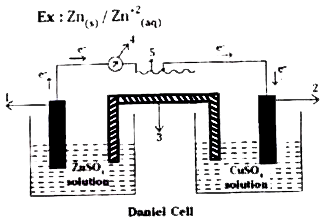Explain the role of redox reactions in titrimetre processes and galvanic cells.Solution in Telugu
Role of redox reactions in titrimetric quantitative analysis :
Titrimetric analysis involves two substances. They are (1) a solution of known concentration or a standard solution and (2) a solution of unknown concentration. The first solution is also known as Titrant. The second solution is also knwon as Titrand. The process of adding a standard solution to the titrand till the reaction is just complete is called titration. The point at which the titrand just completely reacts with the standard solution is called "equivalence point" or "end point,"
In redox reactions the completion of the titration is detected by a suitable method like (a) observing a physical change.
Ex : The light pink colour of KMnO4 titrations.
(b) by using a reagent known as indicator which gives a clear visual change in its colour.
Ex(1) In Cr2O−27 (dichromate) titrations, diphenyl amine is used as a reagent and at the end point it produces intense blue colour due to its oxidation by Cr2O−27.
Ex (2) In the titration of Cu+2 with I− (Iodometry)
2Cu+2(aq)+4I−(aq)→Cu2I2(s)+I2(aq)
The I2 formed in the redox reaction gives a deep blue colour with starch solution, added to the flask.
IN this way redox reaction are taken as the basis for titrimetric analysis with MnO−4,Cr2O−27 etc. as oxidising agents and S2O−23 etc. as reducing agents.
Role of Redox reaction in galvanic cells :
When a zinc rod is kept in copper sulphate solution then the following redox reaction takes place.

In this redox reaction the transfer of electrons from Zn(s) to Cu+2(aq) takes place directly. The same transfer of clcctrons can also be done indirectly in a galvanic call (Daniel cell).
Cells in which chemical energy is converted into electrical energy are called galvanic cells. Daniel cell is a best example for a galvanic cell. The Daniel cell consists of two beakers containing zinc rod dipped in ZnSO4(aq) solution in one beaker and a copper rod dipped in CuSO4(aq) solution in a second beaker. The two beakers are connected by an inverted U-tube, known as salt bridge. The two rods are connected by means of wires to the terminals of an ammeter. Redox reaction takes place contains both oxidised and reduced forms of the respective species. The two types of species present together in each beaker is called a redox couple. Each beaker contains a redox couple. The oxidised and reduced forms are separated by a vertical line or a slash.
Ex : Zn(s)/Zn+2(aq)

In the above arrangement the two redox couples are represented by Zn+2/ZnandCu+2/Cu. As the metal is in two different oxidation states at the interface (say Zn/Zn+2), some potential is developed, which is called 'electrode potential'. These electrode potentials are very useful in metallurgy, electro-plating etc.
In this way redox reaction play an important role in galvanic cells.
Topper's Solved these Questions
- STOICHIOMETRYBOOK - VGS PUBLICATION-BRILLIANTCHAPTER - STOICHIOMETRYEXERCISE - LONG ANSWER QUESTION
13 Videos
- STOICHIOMETRYBOOK - VGS PUBLICATION-BRILLIANTCHAPTER - STOICHIOMETRYEXERCISE - ADDITIONAL QUESTIONS & ANSWERS
10 Videos
- STOICHIOMETRYBOOK - VGS PUBLICATION-BRILLIANTCHAPTER - STOICHIOMETRYEXERCISE - ADDITIONAL QUESTIONS & ANSWERS
10 Videos
- STATES OF MATTER : GASES AND LIQUIDSBOOK - VGS PUBLICATION-BRILLIANTCHAPTER - STATES OF MATTER : GASES AND LIQUIDSEXERCISE - ADDITIONAL QUESTION & ANSWERS
10 Videos
- THE P-BLOCK ELEMENTS - GROUP 13 BOOK - VGS PUBLICATION-BRILLIANTCHAPTER - THE P-BLOCK ELEMENTS - GROUP 13 EXERCISE - LONG ANSWER QUESTIONS
3 Videos
Similar Questions
Write the balanced ionic equation which represents the oxidation of iodine (I−) ion by per-manganate ion in basic medium to give iodine (I) and manganese dioxide (MnO2).
View SolutionCalculate molecular mass of glucose (C6H12O6) molecule.
View SolutionCalculate molecular mass of glucose (C6H12O6) molecule.
View SolutionA balloon is filled with hydrogen at room temperature. It will burst if pressure exceeds 0.2 bar, If at 1 bar pressure the gas occupies 2.27 L volume, upto what volume can the balloon be expanded?
View SolutionHow are borax and boric acid prepared ? Explain the action of heat on them.
View SolutionThe standard e.m.f. of a galvanic cell involving 3 moles of electrons in a redox reaction is 0.59V. The equilibrium constnat for the reaction of the cell is
View SolutionThe standard emf of a galvanic cell involving 3 moles of electrons in a redox reaction is 0.59V. The equilibrium constant for the reaction of the cell is
View Solutionगैल्वेनिक सैल में होने वाली रिडॉक्स अभिक्रिया ................. होती है जबकि विद्दुत - अपघटनी सैल में होने वाली अभिक्रिया ............ नहीं होती है ।
View SolutionThe standard emf of a galvanic cell involving 2 motes of electrons in its redox reaction is 0.59 V the equilibriun constant for the redox reaction of the cell is
View Solutionगैल्वेनिक सेल में रेडॉक्स अभिक्रिया होती है।
View SolutionThe process of electrolysis is redox reaction .Explain .
View SolutionExplain the redox reaction in galvanic cells.
View Solutionఅంశమాపక పద్ధతిలో గాల్వనో ఘటంలో రిడాక్స్ చర్యల పాత్రను వివరించండి.
View SolutionThe standard emf of a galvanic cell involving 2 moles of electrons in it redox reaction is 0.59 V.The equilibrium constant for the redox reaction of the cell is
View SolutionExplain the role of redox reactions in titrimetre processes and galvanic cells.
View Solution
